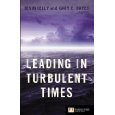
It's no secret that businesses and the people that lead them are having a tough time, even as we inch our way into a recovery. This isn't a great time to be a CEO - it's hard to win and many, in fact, have failed publicly or have kept their jobs but forfeited bonuses or salaries. The average tenure of a CEO hired from the outside, ostensibly to make major change, is on the order of less than four years. And the key business strategy of some companies seems to be "jump in the foxhole until this thing passes over." So a new book, drawing on the collective wisdom of surviving and thriving CEOs, Leading in Turbulent Times, has some interesting lessons for executives who want to stay in the game and find a way forward.
Authors Kevin Kelly and Gary E. Hayes have often been advisors to companies in the middle of a meltdown. Kelly is the CEO of Heidrick and Struggles, a dominant global executive recruiting firm with a strong track record in placing CEOs and Hayes is a leadership consultant and Founding Partner of Hayes Brunswick & Partners who has worked closely with CEOs and C-suite executives who are in a business crisis. These experiences have earned them the access and trust to draw out "lessons learned" from over thirty CEOs, Chairmen and other senior executives who are prevailing in spite of a challenging environment. The CEOs are drawn from companies such as McDonald's, Infosys, Nissan, Marks & Spencer and PWC.
"The book came about after we had a series of conversation with CEOs in various parts of the world about how they were seeing things, how they were coping. What became clear, as we connected the dots, is that they had things to teach each other about staying focused in spite of the environment around them. The continuity was fascinating...they were all facing similar challenges that came on very quickly and were doing the same things to weather the storm," said Kevin Kelly when asked about why they had done the book during the most significant financial crisis in recent memory. "We learned something interesting from Richard Fung of the Li and Fung Group that applies to this situation: the Chinese symbol crisis can mean "opportunity" in a time of "danger". Many of these CEOs are using this time to rebuild their businesses around new opportunities."
Kelly and Hayes found patterns among those who were being successful, across industries and geographies, with implications for anyone working to turn things around in this recession. Three things stood out for them: passion rules and carries the day, hard times call for a mastery of soft skills, especially communication, to motivate and engage people and keeping a long term vision in place and well communicated is the best way to keep focused and positive in spite of necessary firefighting.
The book is organized around various phases of the change process, starting with recognizing that change is coming, moving to mobilizing people to act, navigating a new course, preventing "mutinies", and learning to be flexible in the face of unanticipated developments. These are standard elements of the change management process but what makes them come alive are the highly personal examples from the CEOs interviewed.
According to Gary Hayes, "we expected all the CEOs to talk about managing cost and risk, but what surprised us is the way they spoke with great passion about the need to motivate and engage their people in spite of the crisis and that became the central point in their conversations with us."
What many CEOs struggled with is the extent to which their time needs to be focused on communication. They spend a significant part of their time with subordinates, employees in general, the board, clients and customers and other stakeholders, listening as well as sharing information. So take a look at George Halvorson's practice as CEO of Kaiser Permanente of writing a weekly letter to all employees, former CEO of PWC Sam DiPiazza's structure for deploying communication to 8,000 partners and over 150,000 people and Takeshi Niinami's practice as CEO of Lawson in Japan of spending approximately 70 percent of his time talking and listening to people in the early days of his job.
People need a special kind of leadership when there's a change in strategy or some other major dislocation. Teams that had been managed very loosely, with high delegation, may need to feel the "hand of the leader." George Halvorson provides a wonderful analogy having to do with "winter horses" - saddle horses who spend their winters unridden, in the barn, and who buck off the saddle and rider when they first goes back on in the spring. Read the book to learn more, especially if you are managing teams of Gen Y employees who feel that they never need management in any event.
We know that the recession isn't over and that only time will tell who the real winners and losers are. Moving beyond survival as well as winning has a great deal to do with the core lessons of this book.
